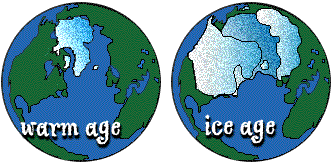|
The
Ice Ages
Many people tried to figure out why the "Ice Ages" happened.
In the 1920s, a meteorologist (a person who studies the weather,
not meteors!) named Milutin Milankovich found a possible explanation:
changes in the orbit of the Earth. The
basic idea is fairly simple. As you probably already know, average
temperatures on Earth depend on the Earth's distance from the Sun.
If the Earth was closer to the Sun, the climate would be hotter
(like Venus), and if the Earth was farther from the Sun, the Earth
would be colder (like Mars). Now if the Earth was the only planet
going around the Sun, its orbit would never change and its climate
would remain constant. But the Moon and other planets are a part
of the Sun's family, and their gravity tugs slightly on the Earth
as they pass nearby, causing the Earth's orbit, and also its climate,
to change by tiny amounts.
The
three main orbital changes Milankovich
studied are:
1. changes in the shape
of Earth's orbit,
2. changes in the tilt of Earth's axis,
and
3. the wobble of Earth's axis.
Each of
these changes are cyclical, that is, they repeat over and over.
During the cycle of any one of these three changes, the Earth tends
to grow a little warmer, and then a little bit cooler. The three
orbital changes are actually all happening at the same time, but
the length of the cycle of each change is different. Most of the
time, the heating and cooling segment of each cycle cancel each
other out, giving Earth a lukewarm climate. But sometimes orbital
changes combine together to make the Earth's climate either very
warm or very cold.

For example,
if the cool segment of the shape cycle occurs at the same time as
the cool part of the tilt cycle, and at the same time as the cool
segment of the wobble cycle, then Presto-Chang-o, you get an ice
age! Its kind of like following directions written by a crazy chef
for making a veggie burger. If the directions said: cool the burger,
then heat the burger, and then cool the burger again, you would
end up with a lukewarm burger. However, if the directions said heat
the burger, then heat it again, and then heat it again, you would
get "burger flambe." But if the directions said cool the
burger, cool it again, and then cool it again, you would get a "glacier
burger."
Now the
question is: Did orbital changes make an ice age that killed the
dinosaurs? Is there any evidence in the rocks for an ice age 65
million years ago? To help you in your search, you might want to
find information about Ice Ages, Ice Epoch, Milankovich cycle, glaciers,
glacial deposits, or climate changes. Good luck!
Back
| Next
|










